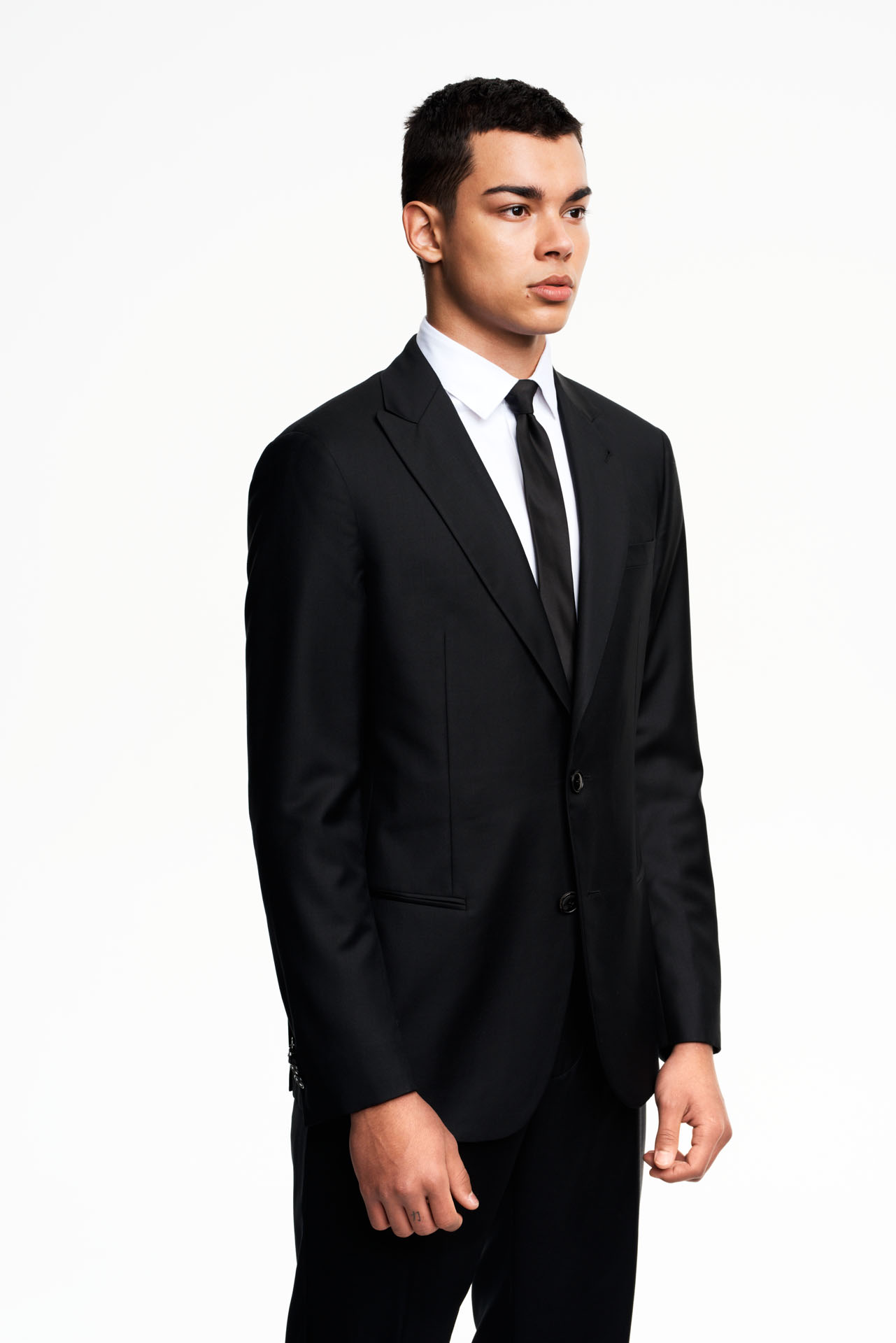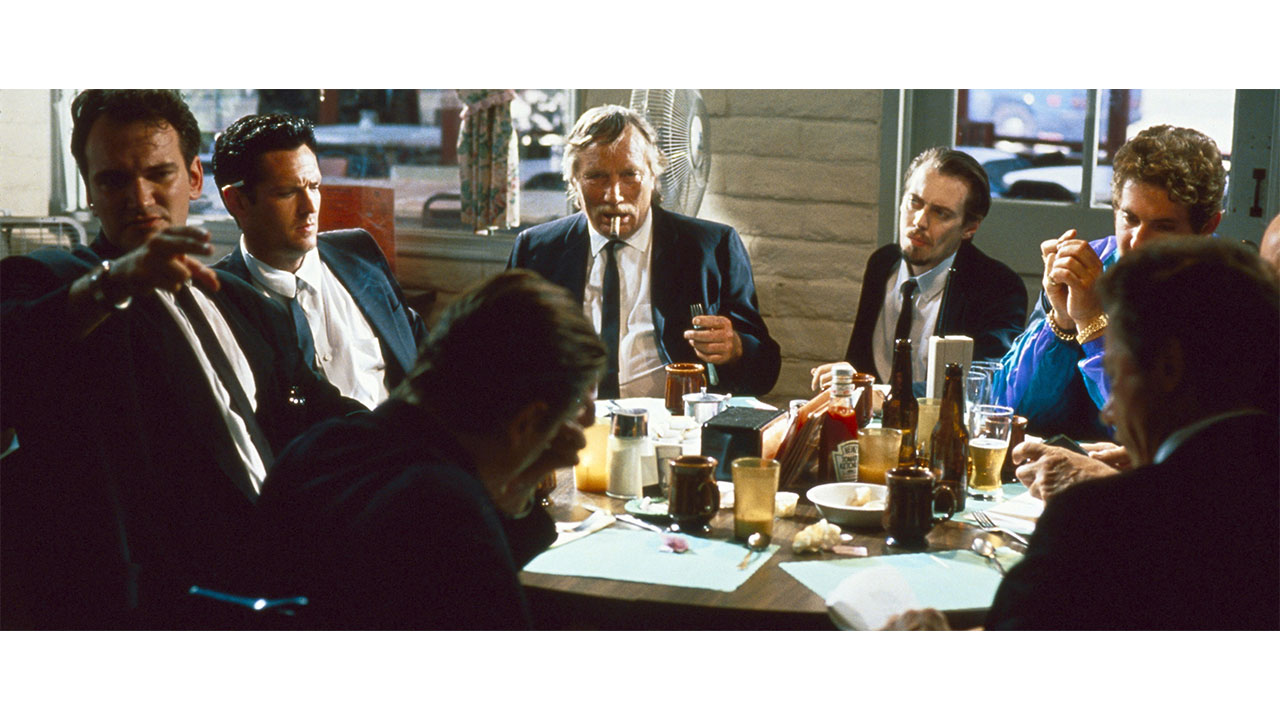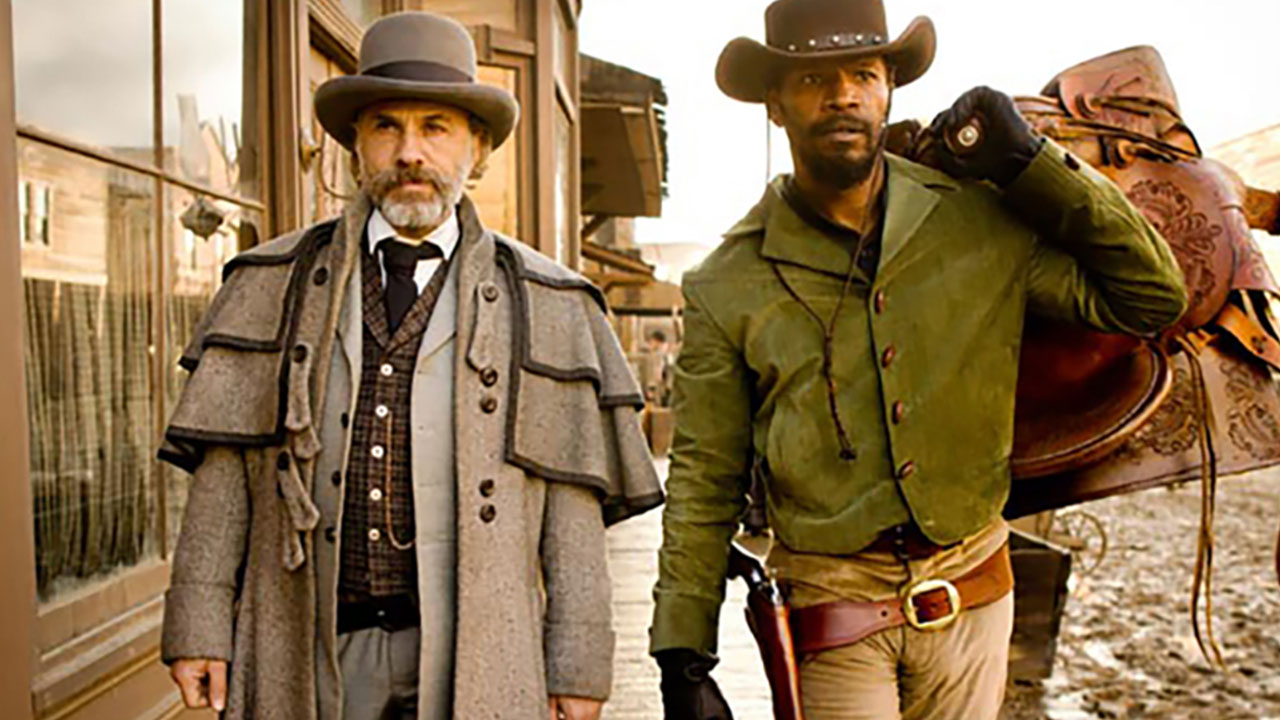Everything
“We have Halloween parties,” remarked Quentin Tarantino during his speech at the 2016 Costume Designers Guild Awards, addressing the fact none of his films had ever won an Oscar or Golden Globe for costume design. Continued the acclaimed director: “I’ve always considered that may be the greatest award”.
There’s no denying the truth in Tarantino’s middle-finger rebuttal. Fancy-dress parties without a sharp-suited Reservoir Dog, a white-shirt-and-cigarette-smoking Vincent Vega or a yellow-tracksuited Bride is no fancy dress at all. Such is the power of a Tarantino film. His repertoire of shock-tastic features encompass the Holy Trinity of cinema experience: explosive narrative both confrontingly coarse and devilishly amusing; characters so rich in idiosyncrasies that they defy stereotypes; and layer-cake costuming that transcends the mere serving of the narrative.
Tarantino is a self-proclaimed movie “nerd” who never enrolled in film school. Instead, as he puts it, he “went to the movies”. His insatiable appetite for even the most obscure of film genres unsurprisingly resulted in his directorial future: that of taking static pulp genres and rebirthing them into juicy, far-fetched, riotous popcorn-spillers. He blitzes box offices and turns critics into sleuths desperate to decipher the meaning behind the meaning. (Will we ever know what was in that briefcase?)
With all due respect, however, one can’t help but want to challenge the Oscar-winning Best Director on his claims on Halloween. Not because he takes too much credit, but rather, too little. While revellers the world over appropriate his characters’ costumes, the auteur himself has stopped short of discussing his inspiration to and influence on some of fashion’s most famed collections, from Tom Ford in the 1990s to Prada’s menswear 2012 and Calvin Klein 205W39NYC’s 2018 collection.
His characters, as unique as the stories in which they live, linger in the public consciousness thanks to mouthy dialogue matched by detail-clad costumes meshing eras, traits and Tarantino’s own graphic imaginings. Their big-screen realisation becomes the stuff of poster-pinups, genuinely influential over the heavyweights of fashion. From Pulp Fiction and Inglourious Basterds to Django Unchained and his anticipated new film, Once Upon A Time In Hollywood, Tarantino’s Halloween immortals are as renegade in narrative as they are in trailblazing style.
The Dog Days

It’s the most usual of all menswear. Black jacket, black trousers, white shirt and black tie. It ruffles no feathers and makes no grand statement, yet this sartorial classic knows its role, and nothing does it better. The suit is the blank canvas of prêt-à-porter menswear. The open stage. The unwritten page. It’s the uniform of the archetypal businessman, the gangster, the crooner. And it’s precisely this chameleon-like quality that endlessly attracts filmmakers and fashion designers alike.
In 1992 Tarantino met with costume designer Betsy Heinmann to discuss his first major directing project, a neo-noir heist film named Reservoir Dogs and set in Los Angeles. Heinmann’s resume is vast and impressive – after Dogs and its mega follow-up, Pulp Fiction, she worked on Almost Famous, Jerry Maguire, and Out of Sight, to name a few – and it wasn’t long before the acclaimed costume designer was helping the then 29-year old film-making freshman flesh out his first film.
As Heinmann explained to ICON: “The Characters in Dogs were all ex-cons, in and out of jail and in need of money. I thought they could go to a thrift store and buy black suits, white shirts, and black ties inexpensively as a disguise for the heist. That became the Reservoir Dogs look. I wanted Vincent and Jules [of Pulp Fiction] to be Reservoir Dogs, too so I dressed them similarly.” Heinmann’s knack for using costume to illuminate a characters’ background is subtle but powerful. “Because Vincent was a bit of a mess. I made this suite out of linen so it would easily look rumpled. Jules had a preacher quality to him, so his suit was very fitted and the collar on his shirt very short, almost like a priest collar,” she explained. This approach appealed to Tarantino’s own love of layered meaning that would go on to become signature of his films. And despite being limited by next-to-nothing budgets and scrappy resources, Tarantino and Heinmann executed two uniquely styled and critically acclaimed films whose influence was widespread and everlasting.
Imagine for a moment that Tarantino’s first two films, Reservoir Dogs and Pulp Fiction — circa 1993, had instead seen the protagonists wear directional trends of the time. Plaid shirts and baggy jeans, perhaps? Leather motos and corduroy trousers? The films themselves would still be considered classics but their image would instead be stamped with a time and date. It was this dedication to character, rather than trend, that preserves these Tarantino films in something of a parallel fashion universe, immune to faux pas and passing fad. The “Dogs” films, as Tarantino and his costume designer Betsy Heimann referred to them, saw their version of the suit become a cool, knockabout uniform for a gun-wielding leading man. This was not the style of suit worn by the antithetical James Bond; instead it was a symbolic suit of armour, a mask for the sinful man beneath.
The global success of both films saw this grittier new suit persona become irrevocably cool and accessible fashion fodder for the everyman. In the seasons following, suiting hit a fashion high. While designers had tailored two-pieces forever, the Tarantino treatment meant an altogether new mood. Tom Ford, then at the helm of Gucci and now synonymous with high-fashion suiting, featured single-breasted jackets, tailored trousers and black ties in his mid-’90s collections. His models were also aptly accessorised with sly “Dog” attitude. At the same time, the father of Italian couture, Giorgio Armani, was invigorated by the suit’s reignition. Armani, who designed chic suiting for films American Gigolo in 1980 and The Untouchables in 1987, was no stranger to the symbiosis between fashion and lm, and his circa ’95 collections drew inspiration from the moment, Tarantino not withstanding.
And while classic suiting is immune to trend, there’s no denying the reincarnation of Tarantino’s “Dog” version. Today’s black suit harks back to his LA-gangster era; new high-fashion slimline ensembles served this time with a dash of irony. That’s not to say directional suiting is left out. Haider Ackermann’s autumn/winter 2018-2019 collection includes relaxed gelato-hued suiting worn sans shirt and accessorised with slicked back Pulp Fiction-style hair and matching pool slides, the kind Vincent Vega might throw on in a remake. Paul Smith’s collars are long and open, while Berluti’s golden satin could easily enjoy a $5 milkshake before taking on a twist competition.
But it’s Armani and Ford who most notably nod to the nostalgic. Among the trend-focused looks within their autumn/ winter collections, they welcomed back sleek, new-wave “Dogs” in chic black suits, as cunning and cool as ever.
Long live the basterds.
In January 2012, two and a half years after the release of Tarantino’s Nazi vengeance film, Inglourious Basterds, Miuccia Prada presented her autumn/winter menswear collection in an impressive red-carpeted hall. It was imposing enough to envision a heated meeting between historical leaders and theatrical enough to imagine Tarantino yelling “Cut!” in the corner. And the blurring of art and life didn’t end there. Regal three-piece suits, starchy tall collars and lieutenant coats decorated with breast pins filled the space on both models and A-listers. Willem Dafoe, Gary Oldman, Adrien Brody and Jamie Bell joined the ranks, so to speak, of Prada’s take on the uniform-swathed man of the ’30s and ’40s. The inclusion of such talent made it clear that Prada’s message was pleasantly satirical. Her gent-in-uniform was one of Hollywood necessity rather than that of historical fact; military garb donned for the purpose of a period film only.
When Tarantino was ready to graduate from his heist-and-hitman era, he did so by setting his sights on new genres to satirise and celebrate. Cult movies are traditionally the stuff of racial, gender and era bias: the martial-arts battle; the war epic; and the spaghetti western. Tarantino would exploit the exploitative, so to speak. And unlike the Dogs films, Kill Bill, Inglourious Basterds and Django Unchained came pre-packaged with expected costuming subtext. Kill Bill is famously flavoured with street-sport athleisure, while Inglourious Basterds and Django Unchained unleashed Tarantino’s new era of historical appropriation. Basterds, set in the France of World War II, was costumed by Polish designer Anna B. Sheppard. The decorated suiting on the SS militia is in comic contrast to the swagger-khakis on Brad Pitt’s American-hero Basterds. Pitt’s cool countenance is not simply a by-product of employing a pretty A-lister: Sheppard’s choice of cravat, perfectly coiffed hair and double-breasted pea coat, cinched by a thick leather weaponary belt, intentionally blurs the lines between macho war hero and untouchable movie star. Django Unchained was the result of Tarantino’s obsession with the spaghetti western, an Italian ’60s sub-genre featuring high levels of violence. Jamie Fox’s protagonist Django is on a singular path to reckoning and, as costumed by Sharen Davis, does so in shades of Pitt’s aforementioned hero with strong jacket, cravat, fashion-cut trousers and low-slung leather belt; his cowboy hat tilting just enough to suggest a sexy baddass who also knows the latest in western chic.
This romanticised, costume-hijacked collection for autumn/winter 2013-2014 could have arguably been drawn upon by Tarantino should he have decided to make a Basterds sequel. Was it any surprise when a year later Mrs Prada employed the talents of Christoph Waltz, the Oscar-winning actor who portrayed SS officer Hans Landa in the film (and King Schultz in Django Unchained), to star in her 2013 advertising campaign? Prada’s current collection shows a new minimalist modernity, offering up a gritty, dystopian uniform featuring, almost exclusively, nylon-heavy athleisure. It’s theatrical but in an entirely different way.
Should the worlds of fashion and Tarantino cinema continue to collide, surely it’s possible that a Mad-Max- influenced epic could be a sparkle in the director’s eye? A well-dressed Yeezy-come-Prada feature that Quentin-ifies the now all-too-common dystopian genre? Dystoploitation, would he call it? It would be an bona de box-office winner.

If Academy Awards were handed out for most theatrical collection, then surely this season’s winner would be Coach 1941, now in the hands of creative director Stuart Vevers. The British designer has successfully reignited the Coach je ne sais quoi since his appointment in 2013. The label’s rapid decline into basic American-mall accessories arrested, it is now at the forefront of “everyone’s-wearing-it” fashion. Vevers’ spring-summer 2018 menswear collection bore grand detail, Vevers heavily inspired by Hollywood’s aesthetic genres, particularly that of the original western. Once again, this was a satirical commentary on a town built entirely on façade; one that can whimsically flip-flop between westerns, indie-underground or the sceney ’90s as it desires.
With looks akin to Tarantino’s gun-slinging gore-fest Django Unchained and even to sequences within Kill Bill, Coach is in good company. Both Louis Vuitton and Christian Dior Homme’s autumn/winter 2018-2019 included Harrington bomber jackets in shades of military khaki that could easily dress Pitt and his group of Basterds, while Etro’s velvet-brocade overcoats, suede jackets and western-print knits were dashingly reminiscent of characters from Django Unchained.
The antithesis to 2018’s normcore-urbanism is this: an unexpected partnership between crisp, new-age suiting and grimy western outfits you might find in a costume shop. We’ll call it When Django Met The Basterds.
Hollywood calling.

For the dressing of Tarantino’s next masterpiece, costume designer Arianne Phillips needn’t look further than Raf Simons for Calvin Klein 205W39NYC autumn/winter 2017-2018. This was Simons’ debut as creative director, one the Belgian-born designer knew was anxiously awaited by his industry peers. One after the other block-coloured western shirting and French-fly trousers swaggered down the runway. Simons’ layering of turtlenecks under shirts has already found favour amongst the fashionable. And who better than Calvin Klein, that most all-American of American labels, to be rolling parallel in aesthetic to the nation’s gore-director-darling and his latest film escapade.
Once Upon A Time In Hollywood chronicles the story of a struggling actor (Leonardo DiCaprio) and his long-standing stunt double (Brad Pitt) who find themselves collaterally involved in the Manson Family murders. The year is 1969 and fashion is getting feverish. Lapels are widening and collars are lengthening. The flare is reducing to a bootleg and stiff denim is infiltrating the everyday for the fashionable man. Simons, whose employer established itself in 1968, revelled in this American history and, for his debut, took a trip to where it all began. Box-cut, cropped denim jackets paired with matching loose-fit jeans drew subtle attention to the label’s origins as well as to Simons’ own fixation with ’70s cinematic tailoring.
One has no doubt, though, that Simons’ celebration of Americana will not bypass the king of preppy USA classicism, the man whose empire also launched in 1968. While Ralph Lauren’s autumn/winter 2018-2019 collection delivered charismatic layering true to his Upstate aesthetic, it was spring/summer 2018 and autumn/winter 2017-2018 that was ’70s leading man worthy. With hits of cowboy detailing, safari suiting and pintucked boiler suits, Lauren and Simons have found an unexpected (and timely) synergy.

Eight months after his first collection, Simons’ follow-up was set as a sequel of sorts. A follow-up that was cinematically darker, influenced heavily by his adoration of Hollywood and all its gore, horror and explicitness. This time he drew inspiration from The Shining, Hitchcock and even ’70s supernatural flick Carrie. An American-derived, western-influenced collection with cinematic sub-genre overtones? Tarantino should have been there, front and centre.
Which brings us to the latest collection. Simons, who was previously creative director at Christian Dior, maximises his fascination with Americana, presenting a distinctly bleak take on modernity. Layers this time include uniform fire jackets, super-oversized coats, unnerving ski masks and robotic gloves. While he insists it’s less “horror”-fied than its predecessor, the overall effect is dark. But remember, this is fantasy and Simons is your storyteller. So in a Tarantino-esque satirical symbol, the models also clutched boxes of popcorn. A suggestion of Hollywood’s razzle-dazzling of global problems? More likely a prop to remind us that it’s just fashion, guys. Enjoy the show..
![]()
THIS ARTICLE APPEARED ORIGINALLY IN THE OCTOBER EDITION OF ICON MAGAZINE.
SUBSCRIBE HERE TO RECEIVE TWO PRINT EDITIONS PER YEAR FOR $15AUD
Cover Image: Instagram @leonardodicaprio



